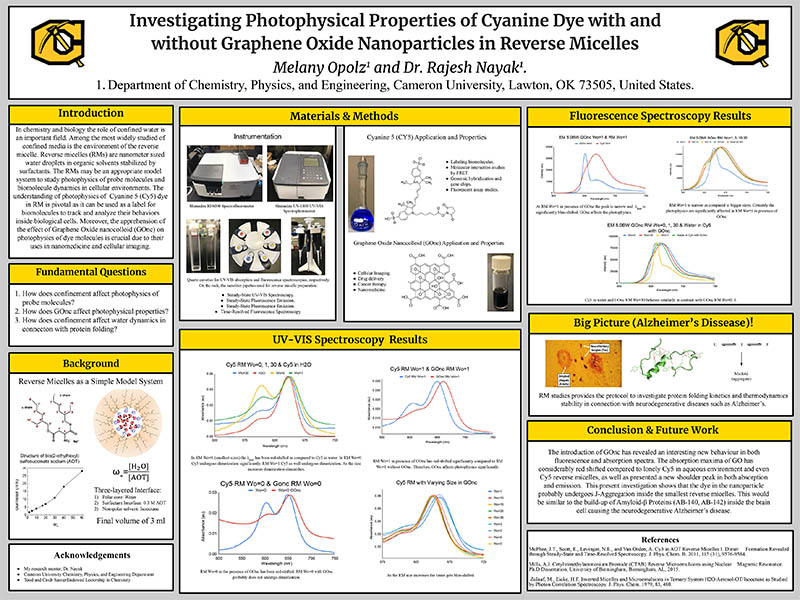
Hover to pan and click to magnify. Click again to pan at full screen.
Melany Opolz, Dept. of Chemistry, Physics and Engineering, Cameron University, Lawton, OK. Faculty Advisor, Dr. Rajesh Nayak, Cameron University, Lawton, OK.
Melany Opolz, Dept. of Chemistry, Physics and Engineering, Cameron University, Lawton, OK. Faculty Advisor, Dr. Rajesh Nayak, Cameron University, Lawton, OK.
ABSTRACT
Introduction: In chemistry and biology the role of confined water is an important field. Among the most widely studied of confined media is the environment of the reverse micelle. Reverse micelles (RMs) are nanometer sized water droplets in organic solvents stabilized by surfactants. The RMs may be an appropriate model system to study photophysics of probe molecules and biomolecule dynamics in cellular environments. Therefore, the understanding of photophysics of probe molecules such as Cyanine 5 (Cy5) dye in RM is pivotal as it can be used as dye labels for biomolecules to track and analyze their behaviors inside biological cells. Moreover, the understanding of the effect of Graphene Oxide (GO) nanoparticles on photophysics of dye molecules is crucial due to their uses in nanomedicine and cellular imaging.
Methods: A protocol was developed to use sodium di-2-ethylhexyl sulfosuccinate (AOT) RMs whose size can be modulated over a wide range of sizes, characterized by the molar ratio of water to surfactant: wo=[H2O]/[surfactant]. Steady-state and time-resolved spectroscopies such as UV-Vis Absorption, Fluorescence emission and Time Correlated Single Photon Counting techniques were employed to determine various photophysical parameters such as quantum yield, fluorescence lifetimes, and band shifts, etc.
Results: The photophysical properties of Cy5 dye inside RMs of varying sizes were compared to the dye inside aqueous environment and it was found that the photophysical behavior of the dye is environment dependent. Furthermore, the experimental observation of the introduction of GO nanoparticles in RMs has revealed interesting photophysics of Cy5 molecules.
Conclusion: This investigation shows that the dyes in GO nanoparticles probably undergo aggregation and exhibit different photophysics in RMs. Furthermore, this study has provided the future protocols to study protein folding kinetics in connection with neurodegenerative diseases such as Alzheimer’s.
Relevance of Study: The study provides a protocol for protein folding in connection with Alzheimer’s Disease. Understanding the reason for the protein folding and mis-folding of the protein would be important to develop an effective cure for a disease that affects millions of people around the world.
